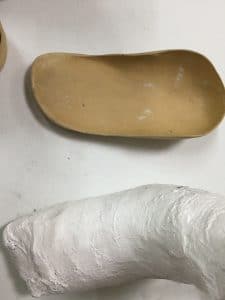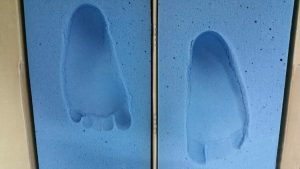I. Overview of orthopedic shoes
Orthopedic shoes, also known as orthopedic shoes, are a kind of rehabilitation engineering aids used for foot and ankle correction treatment. They are used by professional doctors and rehabilitation engineering technicians, based on the patient’s clinical signs and biomechanical test results, in clinical medicine and biomedicine. Under the guidance of engineering theory, it is a kind of functional shoe made by orthopedics and shoemaking techniques.
Orthopedic shoes have a special structural design, which uses biomechanical means to apply a corrective force to the ankles to prevent and correct foot deformities, treat and improve pain, lesions, and joint instability caused by abnormal foot structures, and limit abnormalities The joint activities of the feet can compensate for the lost functions of the feet, delay and improve the occurrence and development of diseases, promote the healthy development of children, and improve the quality of life of patients.
There are two common types of orthopedic shoes: tailor-made personalized orthopedic shoes and finished orthopedic shoes. Ankle orthopedic doctors formulate orthopedic prescriptions based on the patient’s symptoms, signs, and auxiliary foot examination results, and choose appropriate orthopedic shoes for the patient.

Tailor-made orthopedic shoes are personalized design and production according to the patient’s specific symptoms, test results, and foot data, which are more targeted for patients and have better functions. But tailor-made orthopedic shoes take a long time to make and the price is higher. The finished orthopedic shoes have the advantages of low price and high speed due to mass production and low cost, which can be adapted on-site. Health-care treatments for mild foot diseases and foot health can have a certain effect. But for foot deformities caused by clear disease causes, such as cerebral palsy, congenital clubfoot, spina bifida, unequal length of lower limbs, strokes, etc., personalized orthopedic shoes must be customized.
II. The structure of orthopedic shoes
The structure of orthopedic shoes is relatively complicated and generally consists of three parts: upper, sole, and shoe built-in orthosis.
1. The upper is composed of the front upper, the middle of the body, and the heel upper. The upper structure is composed of three parts: fabric, lining, and fixing strap. The fabrics and linings of orthopedic shoes are mostly made of natural leather, which has the characteristics of good air permeability, beauty, durability, and so on. In recent years, some breathable chemical fiber and cloth fabrics have gradually increased in use due to their advantages of lightness, beauty, and rich colors.
The fixing straps of orthopedic shoes are divided into shoelaces and Velcro. Traditional orthopedic shoes are mostly fixed by shoelaces, which have the advantages of stable structure and firm fixation, but they are cumbersome to wear and take off during use. Velcro has the advantage of being easy to put on and take off, and the fixing is firmer, but after a period of use, the sticking force decreases and the fixing effect will be reduced.
2. The sole is composed of the outsole, midsole, and heel. The sole is roughly divided into the following types according to the style and material of the shoe:

Cowhide outsole: Made of natural cowhide, it is strong, durable, and costly.
Rubber outsole: Made with natural rubber as the main material and added various ingredients, it is wear-resistant, non-slip, and slightly heavier.
EVA outsole: Made with ethylene/vinyl acetate copolymer material as the main material and a variety of ingredients, it is light, soft, and has slightly poor wear resistance and poor slip resistance when exposed to water.
PU outsole: It is made of polyurethane and abbreviated as polyurethane as the main material and added with various ingredients. It is light, flexible, and wear-resistant, but it has poor anti-slip performance when exposed to water. The midsole of the shoe is made of cowhide, PHYLON, EVA, PU, and other materials.
3. Built-in orthotics for orthopedic shoes: mostly made of PP, PU, carbon fiber resin, leather pulp, chemical port treasure, hot melt adhesive port treasure, and other materials. The built-in orthotics of the finished orthopedic shoes are molded, and the built-in orthoses of the customized orthopedic shoes need to be customized according to the orthopedic prescription.
4. Special design of orthopedic shoe bottom and heel
1) SACH heel: The rear part of the heel is made of soft and elastic material to reduce the shock of the heel when it hits the ground and relieve the ground reaction force on the heel and ankle joints.
2) Thomas heel: The inner side of the heel extends forward to the midfoot to support the medial longitudinal arch.
3) Anti-Thomas heel: The outer side of the heel extends forward to the midfoot to support the lateral longitudinal arch.
4) Wedge-shaped heel: Insert a wedge-shaped material on the inside or outside of the heel to adjust the force line of the calcaneus.
5) Palm shaking: add curved bars to the weight-bearing area of the metatarsal to change the rolling axis of the foot.
6) Metatarsal bars: Add flat bars to the weight-bearing area of the metatarsals to change the pressure distribution on the soles of the feet.
7) Heightening: Padded height on the sole of a shoe to make up the equal length of the lower limbs.

III. the style of orthopedic shoes
1. The traditional styles are mostly lace styles, common ones are Oxford style, Derby style, and Gibson style.
2. Modern styles have a large range of options. As long as they can meet the design requirements of orthopedic prescriptions and can accommodate enough orthopedic space, they can be used as orthopedic shoe styles. Customized personalized orthopedic shoes can be designed according to the needs of patients. Orthopedic shoe style.
IV. Prescription design of orthopedic shoes:
Formulated by orthopedic doctors with rich experience in clinical corrective treatment, the patient’s disease type, stage, and post-condition should be fully considered, combined with foot physical examination, clinical examination, foot biomechanical examination results, and comprehensive analysis. Orthopedic prescriptions must have a global concept, establish short-term, mid-term, and long-term orthopedic goals, and meet the different needs of clinical treatment and rehabilitation design of orthopedic prescriptions should fully consider factors such as the difficulty of making, the aesthetics, comfort, cost-effectiveness, and psychological impact of orthopedic shoes, and establish a good follow-up mechanism.
V. Data collection of orthopedic shoes:
1. Foot measurement: Use a soft ruler to directly measure data on the foot. The disadvantage is that the error is large and the repeatability is poor.
2. Plaster model taking: Use plaster bandage to make a female model on the foot, and then turn over the male foot model. The disadvantage is that the female plaster mold is easy to deform, and the plaster will shrink and expand after it has solidified.
3. Foot take-out box: Use a dedicated foot take-out template to take the mold, and then rebuild the plaster male mold. The disadvantage is that only the sole data is available, and the error is relatively large.
4. Three-dimensional foot scanning: Use dedicated three-dimensional scanning equipment to accurately establish a digital three-dimensional model of the foot, with convenient data storage and minimal error. The disadvantage is that the equipment is expensive and difficult to handle and transfer.

VI. common biomechanical testing methods for orthopedic shoes:
Plantar pressure test: A dedicated plantar pressure test system is used to test the plantar pressure during static and dynamic walking of the patient, and obtain the force of each part of the plantar in each period, and perform the results Quantitative analysis provides a reliable basis for diagnosis. Among them, the plantar pressure test can obtain the pressure value from a flat-plate plantar pressure test system, or use an insole pressure sensor to obtain the pressure value. After systematic and scientific analysis, the characteristics of foot inversion, internal and external rotation, frequency domain, and time domain are obtained. Use the obtained parameters to design the orthopedic shoes, and after wearing the orthopedic shoes for some time for the plantar pressure test again to compare the correction effects.
Hot blogs:
The Easiest Custom Insoles: Heat Moldable Insoles
Custom insoles, also known as orthotic insoles, are designed to provide personalized support and comfort for individuals with various foot conditions. In [...]
Children’s Insole Size Conversion Chart
The standard sizes for shoe insoles may vary from country to country, making it a headache to choose the right insole for [...]
Do custom orthotics need to be made by a doctor personally?
Custom orthotics do not necessarily need to be made by a doctor personally. While doctors, specifically podiatrists or orthopedic specialists, are often [...]
Do NBA players use custom insoles?
Custom insoles are not only helpful for people with foot health issues, but they also play a significant role in targeting the [...]
